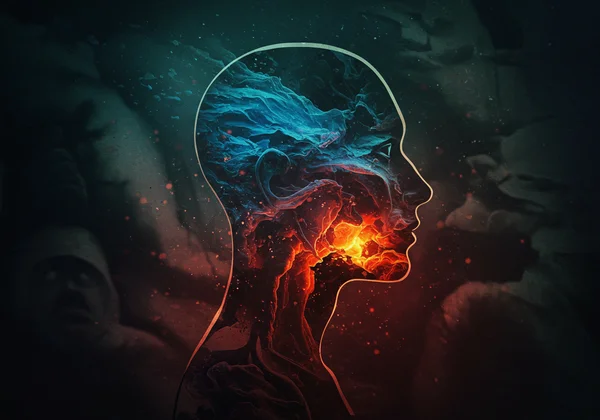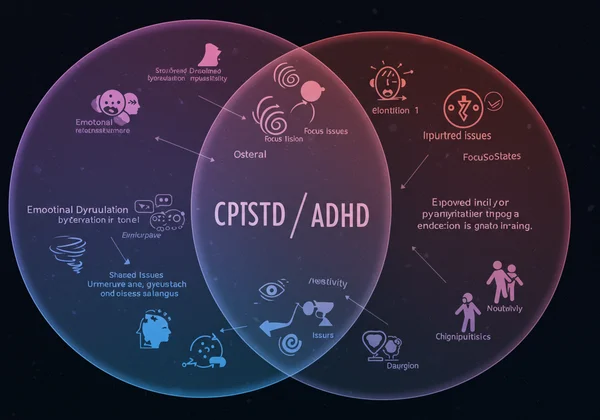CPTSD vs. ADHD: Symptoms, Overlap & Key Differences
Feeling overwhelmed by emotional swings, constant difficulty focusing, or persistent struggles in your relationships? You are not alone. Many find themselves caught in a confusing whirlwind of symptoms, wondering if they are dealing with Complex PTSD (CPTSD) or Attention-Deficit/Hyperactivity Disorder (ADHD). These conditions can look strikingly similar on the surface, making self-understanding a real challenge. How can I tell if I have CPTSD or something else entirely? This guide is here to help you navigate that question. We will clarify the nuances, explore the significant overlap, and highlight the key differences to empower you on your journey toward clarity. Understanding your experiences is the first step, and a great place to start is with a confidential assessment.
Understanding CPTSD: The Echoes of Chronic Trauma
To untangle the knot of symptoms, we must first understand each condition on its own. Complex PTSD is not born from a single traumatic event but from prolonged, repeated trauma where escape felt impossible. This could include childhood neglect, long-term abuse, or persistent emotional invalidation. The core wound of CPTSD is a deep disruption to a person's sense of self and their ability to connect with others.
What is Complex PTSD? Beyond a Single Traumatic Event
Unlike single-incident PTSD, CPTSD is a response to chronic trauma. Think of it as the result of a constant state of threat rather than a single explosion. This long-term exposure fundamentally alters one's brain and nervous system, leading to a unique set of challenges that bleed into every aspect of life, from self-perception to daily functioning. It's a condition of disrupted development and attachment.
Core Symptoms of CPTSD: Disorganization of Self (DSO)
The World Health Organization's ICD-11 recognizes CPTSD with a core feature called Disturbances in Self-Organization (DSO). This framework helps explain the deep internal impact of trauma and includes three main categories of symptoms:
-
Emotional Dysregulation: Intense, overwhelming emotions that are difficult to manage, such as sudden anger, deep sadness, or persistent anxiety.
-
Disturbances in Self-Concept: A negative self-view, often characterized by feelings of worthlessness, shame, guilt, and a sense that you are fundamentally flawed.
-
Difficulties in Relationships: Struggling with trust, avoiding relationships altogether, or being drawn to unhealthy dynamics due to a distorted view of connection.

Decoding ADHD: Challenges in Attention and Self-Regulation
Attention-Deficit/Hyperactivity Disorder (ADHD) is a neurodevelopmental condition, meaning it originates in brain development and is often present from childhood. It primarily affects the brain’s executive functions—the command center responsible for planning, organizing, focusing, and regulating emotions and impulses. It is not a character flaw or a matter of willpower.
What Defines Attention-Deficit/Hyperactivity Disorder?
ADHD is defined by a persistent pattern of inattention and/or hyperactivity-impulsivity that interferes with functioning or development. While many people associate it with children who can't sit still, its presentation in adults is often more subtle and internalized, which is where much of the confusion with CPTSD arises.
Common Manifestations of ADHD in Adulthood
In adulthood, the hyperactive component of ADHD can lessen or manifest as an internal feeling of restlessness. Key challenges often include:
-
Chronic Inattention: Difficulty sustaining focus, being easily distracted, and struggling to complete tasks.
-
Disorganization: Trouble with time management, planning, and keeping physical and mental spaces orderly.
-
Emotional Dysregulation: Similar to CPTSD, adults with ADHD can experience intense emotional reactions and mood swings due to challenges with self-regulation.
-
Impulsivity: Making hasty decisions without considering the consequences, whether in spending, speaking, or actions.

The Overlap: Where CPTSD and ADHD Symptoms Intersect
Here is where the picture gets blurry. Both CPTSD and ADHD can leave you feeling emotionally raw, mentally scattered, and socially disconnected. Understanding this overlap is crucial for validating your experience and seeking the right path forward. If these shared struggles resonate with you, taking a free CPTSD test can be a helpful step in parsing them out.

Emotional Dysregulation: Is it CPTSD or ADHD?
This is one of the most significant points of confusion. Both conditions can lead to feeling like your emotions are a runaway train. In ADHD, this stems from an inherent difficulty in modulating emotional responses. In CPTSD, it's often tied to emotional flashbacks, where a present-day trigger unknowingly activates the intense emotions of past trauma.
Focus and Executive Function: A Shared Struggle
"I can't concentrate" is a common cry for individuals with either condition. For those with ADHD, this is a core feature of their neurotype. For those with CPTSD, difficulty focusing often arises from hypervigilance (the nervous system being on constant high alert for danger) or dissociation (mentally checking out to cope with overwhelming feelings). Both lead to similar outcomes in daily life, such as missed deadlines and unfinished projects.
Impulsivity and Risk-Taking: Trauma Responses vs. Neurodivergence
Impulsive behavior can be a hallmark of ADHD, driven by a need for stimulation or a struggle with self-control. In CPTSD, however, similar behaviors might be a form of trauma response—a desperate attempt to feel something other than emotional numbness, to escape painful memories, or to replay dangerous situations in an attempt to master them.
Key Distinctions: Unpacking the "Why" Behind the Symptoms
While the "what" (symptoms) can look identical, the "why" (origin) is profoundly different. Teasing apart these root causes is essential for accurate understanding and effective healing. This exploration is deeply personal, and tools like an online screening test can provide a structured way to reflect on your experiences.
The Role of Trauma History and Origin of Symptoms
This is the most critical differentiator. CPTSD is, by definition, caused by trauma. The symptoms are a direct result of what happened to you. ADHD is a neurodevelopmental condition that is largely genetic and exists from a young age, regardless of life experiences. A key question to ask is: Did these symptoms exist before the trauma, or did they emerge and intensify as a result of it?
Internal World: Dissociation vs. Mind-Wandering
While both can lead to a sense of being "checked out," the internal experience is different. In CPTSD, this is often dissociation—a protective mechanism to disconnect from overwhelming pain or memories. It can feel like you're watching your life from outside your body. In ADHD, it's typically mind-wandering or "zoning out," where the brain simply shifts its focus to something more interesting or less mentally demanding.
Interpersonal Relationships: Fear of Abandonment vs. Social Awkwardness
Difficulties with relationships are central to both. In CPTSD, these struggles are rooted in deep-seated fears of abandonment, betrayal, and an inability to trust, all stemming from past relational trauma. In ADHD, challenges may arise from missing social cues, interrupting others, or emotional overreactions, which can be misinterpreted by others but aren't necessarily driven by a core fear of abandonment.
Seeking Clarity: Why an Accurate Diagnosis Matters
Untangling these threads isn't just an academic exercise—it has a profound impact on your path to healing. The strategies that help manage ADHD are very different from the trauma-informed approaches needed to heal CPTSD. Getting it right means getting the right support.
The Benefits of a Differentiated Understanding
Knowing the root cause of your struggles can be incredibly validating. It allows you to shift from self-blame ("Why can't I just focus?") to self-compassion ("My brain is trying to protect me" or "My brain is wired differently"). This understanding informs effective treatment, whether it's trauma therapy like EMDR for CPTSD or a combination of medication, coaching, and therapy for ADHD.

Your First Step: Understanding Your Symptoms
Your journey to clarity begins with self-exploration in a safe, structured way. While only a professional can provide a diagnosis, understanding your symptom patterns is a powerful first step. By examining your experiences through a clear lens, you can gather the information you need to have a more productive conversation with a healthcare provider. Are you ready to take the first step?
Your Path to Understanding and Healing
Untangling the intricate web of emotional and attention-related challenges can be overwhelming, particularly when CPTSD and ADHD present with such similar struggles. Yet, by delving into the unique origins and internal landscapes of these conditions, you empower yourself to move beyond confusion and toward genuine understanding. This exploration marks not an endpoint, but a vital beginning—a step toward naming your experiences and charting a clearer course for your personal healing.
Ready to gain a clearer picture of your own experiences?
Take our free, confidential, and scientifically-backed CPTSD Test today to gain personalized insights into your symptoms. This is a powerful, private first step on your path to understanding.
Disclaimer: This article is for informational purposes only and is not a substitute for professional medical advice, diagnosis, or treatment. Always seek the advice of a qualified mental health professional with any questions you may have regarding a medical condition.
Frequently Asked Questions About CPTSD, ADHD, and Their Overlap
Can you have both CPTSD and ADHD simultaneously?
Yes, it is entirely possible to have both. This is known as co-morbidity. Chronic trauma can exacerbate underlying ADHD symptoms, and having ADHD can make an individual more vulnerable to experiencing trauma. In these cases, a comprehensive and integrated treatment plan that addresses both conditions is essential for healing.
How can a professional distinguish between CPTSD and ADHD symptoms?
A qualified professional will conduct a thorough diagnostic evaluation. This typically includes a detailed personal history (especially regarding trauma), developmental history (looking for signs of ADHD in childhood), standardized assessments, and clinical interviews. They look for the "why" behind the symptoms, not just the symptoms themselves, to make an accurate diagnosis.
What kind of trauma can lead to CPTSD that might be confused with ADHD?
Chronic childhood emotional neglect is a significant one. A child who is consistently ignored may develop attention-seeking behaviors (looking like hyperactivity) or may retreat inward and appear "spacey" (looking like inattention). The constant stress can also impair the development of executive functions, creating symptoms that directly mimic ADHD. If you suspect a link, you can explore your symptoms with our screening tool.
If I have symptoms of both, which condition should I address first in therapy?
This is a decision best made with a mental health professional. Often, the first priority is establishing safety and stability. For many, this means addressing the trauma symptoms of CPTSD first, as hypervigilance and emotional flashbacks can make it difficult to engage in other types of therapy. However, for others, managing ADHD symptoms might be the first step to create enough stability to do deeper trauma work.